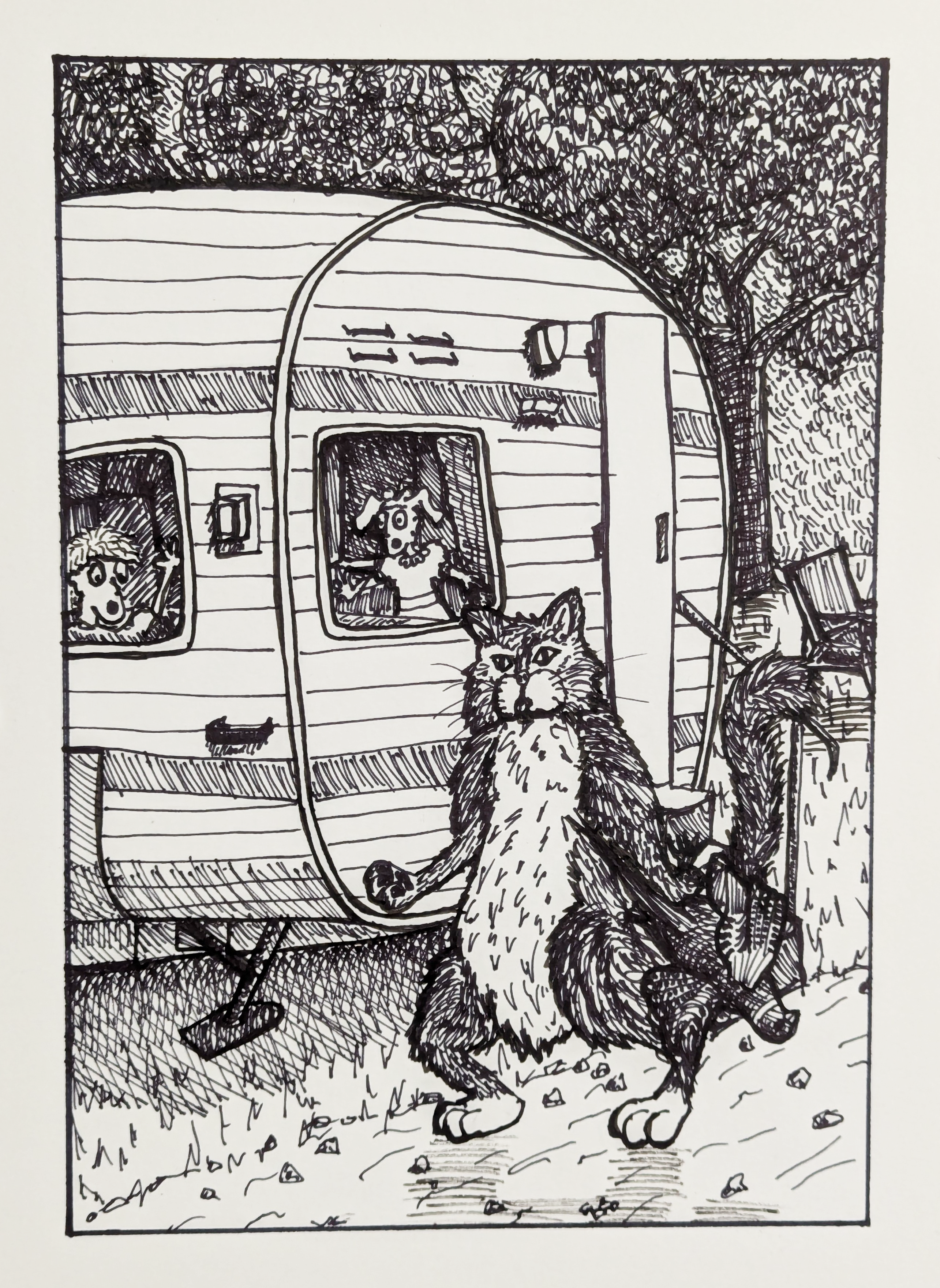This one is a great example of how the internet can both lead you astray, and bring you back home.
So when I went down this path of cryptids drawings and descriptions/classifications I knew (and hoped) that I would be looking into more than a few I had never heard of.
Somehow even with my love of cartoons, I had missed this one. I mention cartoons because this one and the BS online about it appears to be a product of a particular network that makes and markets some pretty good ones…and has a fairly popular show about this one. I have never watch it, but the info I read online referred to it when discussing this alleged creature. That same website mentions a tale of a couple girls in a caravan park (trailer park) in a town near Fiskerton, Lincolnshire that supposedly saw this cat man like creature eating a pheasant and ran over to the pub to tell their parents.
I thought it was kind of goofy, so instead of drawing the haunting black cat they described, I drew it like an oversized housecat on two legs carrying a pheasant. Still a fun image of that particular story but it is BS.
It turns out, the legend of the Fiskerton Phantom is actually a ghost story from that region and is much older than the BS than “animation station” has marketed, sold, and caused a well known cryptid site or two to republish BS.
Here is the background on the actual Fiskerton Phantom GHOST STORY- not cryptid and definitely not a cat man:
- Primary Name: Fiskerton Phantom
- Other Names: Lincolnshire Specter, Phantom of Fiskerton
Known Origin and Basic Lore:
- Origin: The legend of the Fiskerton Phantom originates from Fiskerton, a village in Lincolnshire, England. The lore dates back to the early 20th century, with tales told by local residents.
- Basic Lore: The Fiskerton Phantom is said to be a ghostly figure that haunts the outskirts of the village, particularly near the ancient St. Clement’s Church. It is believed to be the restless spirit of a wronged individual, possibly a monk or a villager who met a tragic end.
Significant Sightings:
- 1932: A farmer claimed to have seen a shadowy figure gliding across his field late at night, disappearing near the church.
- 1958: A group of teenagers reported an encounter with a translucent, hooded figure while camping near the churchyard.
- 1987: A local historian researching the church’s history described an eerie encounter with a cold, ghostly presence during an overnight stay in the village.
Physical Description:
- Appearance: The Fiskerton Phantom is often described as a tall, shadowy figure wearing a long, hooded cloak. Its face is usually obscured, adding to its spectral and mysterious nature.
- Distinct Features: Some accounts mention glowing eyes and an ethereal, almost transparent body that seems to hover rather than walk.
Behaviors:
- Movement: The phantom is said to glide silently, often appearing suddenly and vanishing just as quickly.
- Interactions: Witnesses report feeling an intense chill and a sense of dread in its presence. It is generally non-aggressive but profoundly unsettling.
- Frequency: Sightings are sporadic, with no predictable pattern, contributing to its enigmatic reputation.
Abilities:
- Invisibility: The ability to appear and disappear at will.
- Ethereal Presence: Can pass through solid objects and is not bound by physical laws.
- Telepathy: Some witnesses claim to hear whispered messages or feel an intrusive presence in their minds.
Preferred Habitat:
- Location: The phantom is most often seen near St. Clement’s Church and the surrounding countryside.
- Environment: Prefers quiet, isolated areas with historical significance, such as old churches, graveyards, and abandoned buildings.
Range of Sightings:
- Geographic Range: Primarily reported in and around Fiskerton, Lincolnshire, but there are occasional reports from nearby villages and rural areas.
- Temporal Range: Sightings have been reported sporadically over the past century, with clusters of reports during the 1930s, 1950s, and 1980s.
Likelihood of Existence Based on Similar Species:
- Comparison to Other Spectral Entities: The Fiskerton Phantom shares characteristics with other regional ghost legends, such as the Grey Lady of Rufford Abbey and the Black Monk of Pontefract.
- Folkloric Consistency: Ghost stories often arise from a combination of historical events, local lore, and psychological phenomena. The consistency in descriptions and behaviors across different accounts lends some credibility to the legend.
- Scientific Perspective: From a scientific standpoint, the existence of ghostly entities remains unproven. Psychological explanations, such as pareidolia (seeing patterns in randomness) and the power of suggestion, provide alternative interpretations for these sightings.
All that said, there are a variety of werecats and other cat man like creatures we can talk about at another time….back to the research room.


